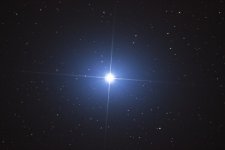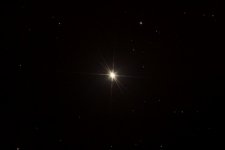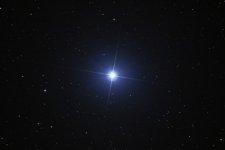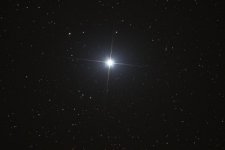

Uncommonly Bright
The ten brightest stars in our northern skies are: Sirius, Arcturus, Vega, Capella, Rigel, Procyon, Betelguese, Altair, Aldebaran, and Spica. Of the ten only four are bright because they are close and they are the only four main sequence stars. If we were to add another ten to the list, only three more would be main sequence. The majority of bright stars are rather far away and are anything but typical.
 |
 |
 |
 |
Sirius is an A1 V star. Recall the classifications O, B, A, F, G, K, M which are in order of hottest to coolest, blue to red, and also from rarest to most common. The prevalence of A class stars is about 1 in 150. The colors are sub-divided 1 - 9. So A1 is close to being the hottest A category star. The V means main sequence. Main sequence stars are fusing hydrogen in their cores. Sirius has twice the mass of our sun and shines 25 times brighter. At 8.6 light years it is the 6th closest star system. And it is a star system. Sirius has a white dwarf companion that started out brighter than Sirius 250 million years ago. It burned through its fuel by 120 million years ago, swelled to a red giant, and then shrunk to a solar mass, carbon-oxygen, white dwarf with a radius similar to Earth's. Sirius has an apparent magnitude of -1.46, but isn't as bright as Venus or Jupiter, and is sometimes outshined by Mars and Mercury.
The next two brightest stars only appear in the southern sky -- Canopus and Alpha Centauri with apparent magnitudes of -0.72 and -0.27. Alpha Centauri is the closest star system. Alpha Centauri is a G2 V star just like our sun while Canopus is a 310 light year distant yellow supergiant -- F0 Ib.
Arcturus is a K1 III star. The roman numerals I, II, III, IV, V stand for super giant, bright giant, giant, sub-giant, and main sequence respectively. Arcturus is an orange giant with 26 times the sun's radius, weighing in at 1.1 solar masses, and shining about 100 times brighter than our sun. At 8 billion years of age it is no longer fusing hydrogen in it's core and is just beginning to leave the main sequence toward the red giant branch. It will expand, cool, and eventually blow off its outer layers and shrink to a white dwarf. This is our sun's fate in about 5 billion years. Though similar in mass to our sun and being only 37 light years away, Arcturus may not be from around here. It has a much lower metallicity than disk stars and it has a much higher proper motion than stars in our neighborhood. It and other stars of the "Arcturus Stream" may have been captured from a dwarf satellite galaxy as it passed near or through the Milky Way's disk.
Vega is an A0 V star with an apparent magnitude of 0.03 and was originally the zero point for the magnitude scale. It has 2.1 solar masses and is about double the diameter of our own Sol. It is 25 light years away and is about half way through it billion year main sequence life time. Vega's pole is aimed at us and it is rotating incredibly fast, completing a rotation in 12 hours. It's equatorial speed is about 500 times that of Earth's. Thus it's shape is an oblate spheroid with it's equatorial diameter being nearly 20% greater than it's polar diameter.
Capella is really a pair of stars -- G8 III and G1 III. They are both yellow giants with magnitudes of 0.76 and 0.91 and are about 42 light years away. One has 2.6 times the sun's mass and the other 2.7 The orbital separation between the two stars is similar to the sun - venus distance. Both stars have diameters on the order of 10 million miles or about 1/10 of the orbital separation between them. This binary pair was discovered spectroscopically and verified with interferometry. The pair are 5 billion years old and began as A class stars and are now migrating off the main sequence to become red giants.
Rigel is a B8 Ia blue super-giant shining at an apparent magnitude of 0.12. Rigel would just fit inside the orbit of Mercury and is about 860 light years away in Orion. At 18 solar masses, Rigel is destined become a type II supernova in the near future. It has already been through a red giant phase and has shed outer layers which are expanding into a shell. It will likely become a red giant again before collapsing and exlpoding.
Procyon is an F5 IV star -- a 1.4 solar mass yellow sub-giant. It is 0.34 in magnitude and 11.5 light years away. This brightest star in Canis Minor, like Sirius in Canis Major, has a white dwarf companion of about .6 solar masses. Procyon is about 2 billion years old and is just about to leave the main sequence and cool to a red giant. It's companion star was more massive, evolved more quickly, and became a dwarf more than 1.5 billion years. Due to its proximity, Procyon may some day in the future become the brightest star in our skies for a time when it becomes a red giant.
Betelguese is M2 Ia red super-giant and has an apparent magnitude of 0.42. Red super-giants tend to be incredibly larger than blue super-giants and Betelguese might well extend to Jupiter's orbit if it were at the center of our solar system. It is 640 light years away, is more than 7 million years old, and could go supernova any time. Betelguese began its life as a 15 solar mass O class star. It will end as a Type II supernova and it's core will collapse to a neutron star. It will outshine the moon and be visible in daytime skies for several months. It is difficult to predict exactly when this catyclism will occur because the activity in the core is well hidden by the overlying layers. If we could detect the core's neutrino emissions, we could determine which nuclear fuel was fusing in the core and thus determine a rather specific time frame for what will likely be the next bright supernova visible from Earth. The last such nearby event was in 1604.
Altair is an A7 V main sequence white star with a magnitude of 0.77. It is 16.75 light years away, has a mass 1.8 times the sun and is about 1 billion years old. Altair's radius is probably twice the sun's.
Aldebaran is a K5 III orange giant shining at 0.85 magnitude. At 65 light years it is almost twice as far as Arcturus which is also an orange giant. This brightest star in Taurus weighs in at 1.7 solar masses compared to Arcturus' 1.1 solar masses. It's radius is more than 40 times that of the sun.
Spica is a B1 III blue giant. It's magnitude is 1.04 and is 260 light years away. At 10 solar masses, Spica will end its life as as type II supernova. It just beginning to leave the main sequence. Spica has a B2 V companion with about 7 solar masses which orbits the system's epicenter every 4 days.
The stars we see with the naked eye are more unusual than not. The closest stars are much more representative of the real distribution of stars. Proxima Centauri is the closest star -- an M5 V and at magnitude 11.1 it is invisible by 5 magnitudes. It is only 4.24 light years away. But it is one of the most common kind of stars.
| O | B | A | F | G | K | M | |
| 91 brightest | 4 | 30 | 20 | 8 | 3 | 19 | 6 |
| Main sequence of 91 brightest | 0 | 7 | 13 | 0 | 2 | 0 | 0 |
| 75 closest | 0 | 0 | 1 | 1 | 3 | 6 | 49 |